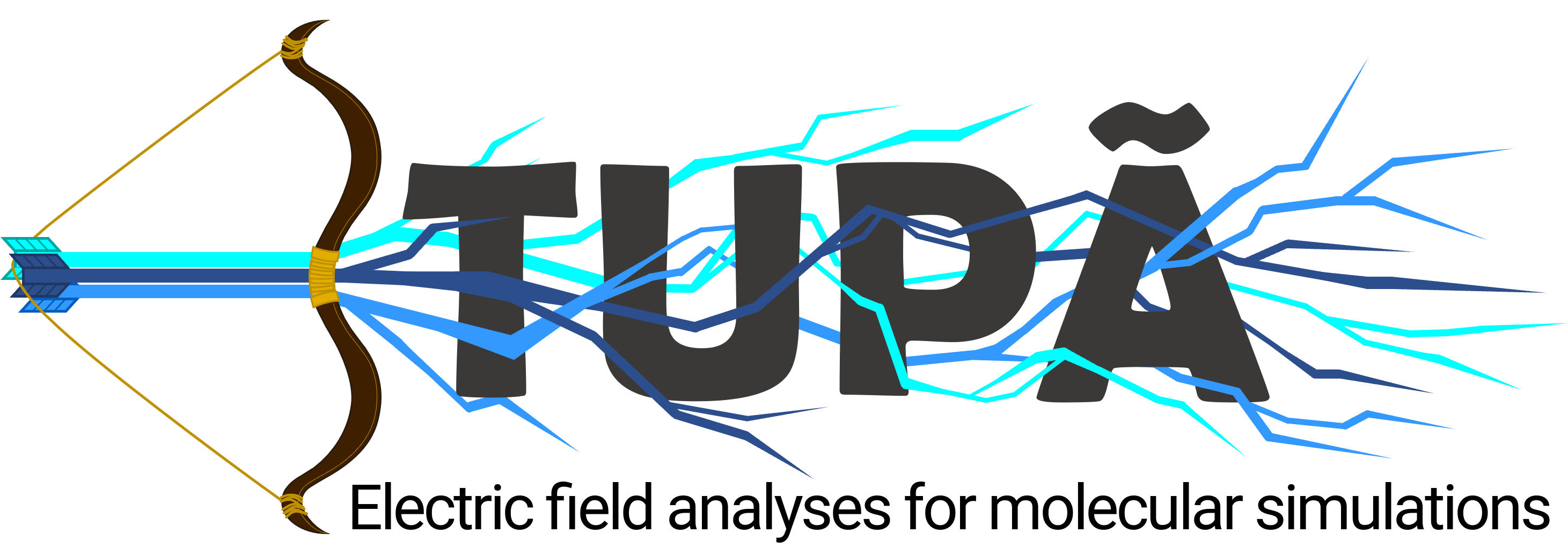
What is TUPÃ?
TUPÃ (pronounced as tu-pan) is a python algorithm that employs MDAnalysis engine to calculate electric fields at any point inside the simulation box throughout MD trajectories. TUPÃ also includes a PyMOL plugin to visualize electric field vectors together with molecules.
Required packages:
- MDAnalysis >= 2.0.0
- Python >= 3.x
- Numpy >= 1.2.x
Installation instructions
First, make sure you have all required packages installed. For MDAnalysis installation procedures, click here.
After, just clone this repository into a folder of your choice:
git clone https://github.com/mdpoleto/tupa.git
To easily use TUPÃ, export the pathway to the executable TUPA.py in your ~/.bashrc:
export PATH="/path/to/the/cloned/repository/":$PATH
TUPÃ Usage
TUPÃ calculations are based on parameters that are provided via a configuration file, which can be obtained via the command:
TUPA.py -template config.conf
The configuration file usually contains:
[Environment Selection]
sele_environment = (string) [default: None]
[Probe Selection]
mode = (string) [default: None]
selatom = (string) [default: None]
selbond1 = (string) [default: None]
selbond2 = (string) [default: None]
probecoordinate = [float,float,float] [default: None]
file_of_coordinates = (pathway to file) [default: None]
remove_self = (True/False) [default: False]
remove_cutoff = (float) [default: 1 A ]
[Solvent]
include_solvent = (True/False) [default: False]
solvent_cutoff = (float) [default: 10 A]
solvent_selection = (string) [default: None]
[Time]
dt = (integer) [default: 1]
[Box Info]
redefine_box = Whether or not provide explicit box dimension information.
boxdimensions = Box dimension information [A,B,C,Alpha,Beta,Gamma]. A,B
and C are the edge lengths (in Angstrom). Alpha, Beta
and Gamma are the box internal angles (in degrees)
A complete explanation of each option in the configuration file is available via the command:
TUPA.py -h
TUPÃ has 4 calculations MODES:
-
In
ATOMmode, the coordinate of one atom will be tracked throughout the trajectory to serve as probe point. If more than 1 atom is provided in the selection, the center of geometry (COG) is used as probe position. An example is provided HERE. -
In
BONDmode, the midpoint between 2 atoms will be tracked throughout the trajectory to serve as probe point. In this mode, the bond axis is used to calculate electric field alignment. By default, the bond axis is define asselbond1 ---> selbond2. An example is provided HERE. -
In
COORDINATEmode, a [X,Y,Z] coordinate will serve as probe point in all trajectory frames. An example is provided HERE. -
In
LISTmode, a list of [X,Y,Z] coordinates will serve as probe points, one for each trajectory frame.
IMPORTANT:
- All selections must be compatible with MDAnalysis syntax.
- TUPÃ was designed to work with
ORTHORHOMBICbox types. We are working to support for rhombic dodecahedron and truncated octahedron boxes. - Trajectories MUST be re-imaged before running TUPÃ. Make sure your probe is centered in the box and does not rotate.
- Molecules in
solvent_selectionbeyond the PBC are re-imaged. This is achieved by applying thearoundselection feature in MDAnalysis and properly shifting the coordinates. - If using COORDINATE mode, be mindful that our code does not account for rotations and translations of coordinates. Be mindful of the coordinate selection.
TUPÃ PyMOL Plugin (pyTUPÃmol)

pyTUPÃmol is a PyMOL plugin to plot electric field vectors alongside other molecules. By definition, an arrow CGO object is created starting at a given coordinate [X,Y,Z] and has the size of the magnitude of the provided electric field.
Our plugin has 3 functions that can be called via command line within PyMOL:
- efield_point: create a vector at a given atom or set of coordinates.
efield_point segid LIG and name O1, efield=[-117.9143, 150.3252, 86.5553], scale=0.01, color="red", name="efield_OG" - efield_bond: create a vector midway between 2 selected atoms.
efield_bond resname LIG and name O1, resname LIG and name C1, efield=[-94.2675, -9.6722, 58.2067], scale=0.01, color="blue", name="efield_OG-C1" - draw_bond_axis: create a vector representing the axis between 2 atoms.
draw_bond_axis resname LIG and name O1, resname LIG and name C1, gap=0.5, color="gray60", name="axis_OG-C1"
To install pyTUPÃ plugin in PyMOL, click on Plugin > Plugin Manager and then “Install New Plugin” tab. Choose the pyTUPÃ.py file and click Install.
Citing TUPÃ
If you use TUPÃ in a scientific publication, we would appreciate citations to the following paper:
Marcelo D. Polêto, Justin A. Lemkul. TUPÃ: Electric field analysis for molecular simulations, 2022.
Bibtex entry:
@article{TUPÃ2022,
author = {Pol\^{e}to, M D and Lemkul, J A},
title = {TUPÃ: Electric field analyses for molecular simulations},
journal = {Journal of Computational Chemistry},
volume = {43},
number = {16},
pages = {1113-1119},
doi = {https://doi.org/10.1002/jcc.26873},
url = {https://onlinelibrary.wiley.com/doi/abs/10.1002/jcc.26873},
eprint = {https://onlinelibrary.wiley.com/doi/pdf/10.1002/jcc.26873}}
}
Why TUPÃ?
In Brazilian folklore, Tupã is considered a “manifestation of God in the form of thunder”. To know more, refer to this.
Contact information
E-mail: mdpoleto@vt.edu / jalemkul@vt.edu
